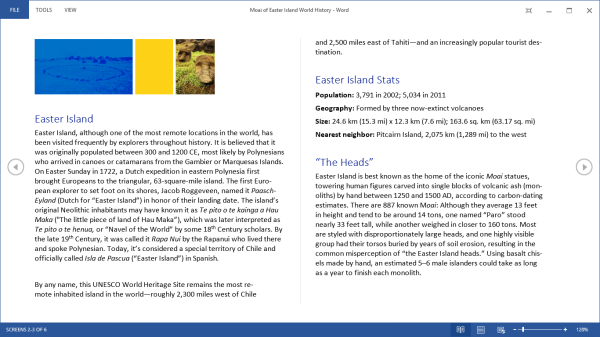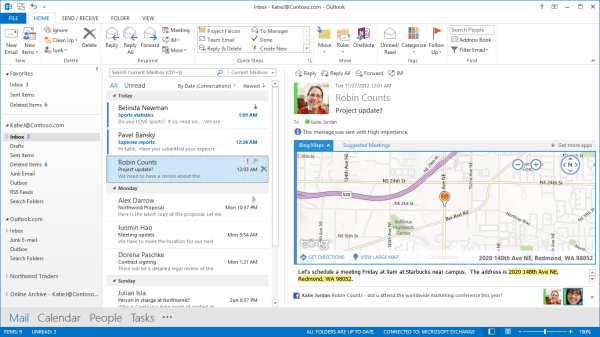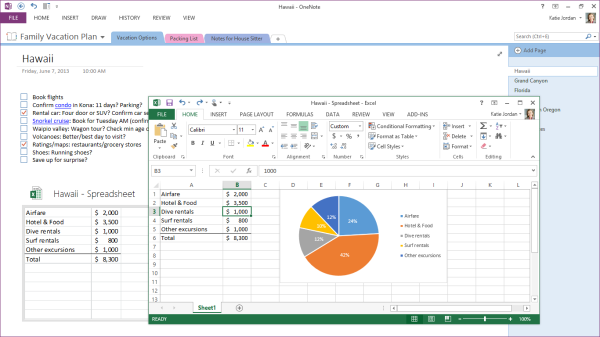Three Months with Microsoft's Office 365
by Vivek Gowri on January 31, 2013 11:59 PM EST- Posted in
- Microsoft
- Cloud Computing
- Office 2013
- SkyDrive
Word 2013 has a couple of nice features worth calling out. One is a viewing mode designed specifically for reading, which is pretty similar in theory to Reader mode in Safari, with text reflowing in columns to fit the display and all navigation and editing tools being hidden to present the document in a consumption-centric manner. The other is much better handling of PDFs - Word 2013 can now open PDFs and treat most content (text, tablets, formatting) exactly the same as standard Word docs. If you’ve ever had to deal with the nightmare of copying content from PDFs to Word, this is wonderful news. Unfortunately, now I’m done with college; it’s unfortunate that Microsoft didn’t decide to implement this in Word 2007 when it would have been legitimately useful to me. (Sidenote: perhaps this is a sign that I’m getting old, but I’ve had a number of moments in the first month of this year when I see new tech products and think to myself “Damn, I would have killed for that 5 years ago when I was an undergrad.”)
PowerPoint comes with significantly better audio and video media support, the ability to add pictures from online directly to the presentation instead of having to save and insert them, a new presenter view when you have a second screen (which is done automatically), more (and better) themes, some cool new transitions (in a category called “Exciting”), and better sharing and editing tools.
Excel’s improvements are primarily related to new charting options, but also a couple of new data tools. The new chart object styles are awesome, and the customizability of the data point styles and transparencies is much easier than it used to be. Other than new content and the visual refresh, the way you interact with the software hasn’t fundamentally changed much with the added features, which is why I’m kind of glossing over Excel and PowerPoint. They’re evolutionary improvements that don’t radically alter the user experience.
Outlook has been redesigned to look like a much more powerful version of the Windows 8 Mail application, with a colour scheme change from gold to blue. Inline replies are now the default, there are plenty of animations, and social networking integration is being touted as one of the more important new features. Clearly, this is not my father’s Outlook we’re talking about. It takes some of the better features from current mobile mail applications and integrates them into what was already the gold standard in desktop mail programs. There are new flyover boxes (called Peeks) to quickly show you schedule, calendar, or contact details without switching windows. The contact manager also does a better job of consolidating multiple contact details into a single card to reduce duplicates. Faster search, better filtering, and new views and in-line attachment and Bing map previews make the 2013 edition the sleekest and easiest version of Outlook yet. After using Outlook for a few days, going back to the Mail app is just a painful and torturous exercise.
With Office 2013, OneNote is making the jump from interesting and useful Office application to really being a vital component of the Office suite. With the rise of tablet computing and the touch-centric nature of Windows 8, this is understandable, particularly since most of the Intel-based tablets are coming with Wacom, N-Trig, or other active (pen-input) digitizers and even the Windows RT slates work well when paired with capacitive styli. That most Windows RT slates don’t come with capacitive pens out of the box is a failing of the device manufacturers, since the platform really lends itself to pen input.
OneNote 2013 features a lot of cross platform integration, with easily embedded objects and Office files (which automatically update when changed). So, if I was to put an Excel grocery list file into OneNote, any changes I made to it in Excel would be reflected in OneNote as well. Outlook meeting integration gives OneNote much more scope in the business realm than it previously had, particularly when combined with the improved search and linked audio features. Better inking, photo snipping, auto-save, and a full-page reading view just improve what OneNote was already great for.














113 Comments
View All Comments
N4g4rok - Friday, February 1, 2013 - link
Just being in the article doesn't imply that it's fact. He's entitled to his opinion, as are you. No reason to continue the use of the phrase 'fanboi.' It gets nothing accomplished.CaedenV - Friday, February 1, 2013 - link
While $100/year for 5 machines is not bad, I do not have 5 machines. In fact I use to have 3 machines at home, 2 desktops and 1 laptop, but our new Lumia 920s have replaced the need for the laptop and it has sat unused for the last 2 months that we have had our phones, so we will likely get rid of it before long.In the past I have upgraded Office Home every 2 generations (~6 years), which breaks down to ~$12.50 per year per machine for 2 machines, which is an easy pill to swallow. I understand that I am getting a lot more out of the new package, but $50/year/machine (because I am not going to buy more computers just for the sake of having them) is a bit on the insane side of things.
I played with the beta, and loved everything about it except for the lack of a dark color theme (easier on the eyes at night), but unless they come out with a 2 machine $40 install or 3 machine $60 install option then there is just no way I will buy it. That would already be a major increase in the amount of money MS would be getting out of me for Office, and my usage would not be all that different than it currently is, so it would not me that much extra effort for MS to invest in supporting me as a user
I hardly feel like openoffice is an adequate replacement for MS Office... but then again it is free yet capable, while this new office demands a lot more money out of me.
CaedenV - Friday, February 1, 2013 - link
OK, so I have a MS account, and my wife has a MS account, and my kiddos have MS accounts (though it will be a few years before they actually use them). We have 2 computers in the house; My machine, and my wife's machine. Lets say that I purchase Office 365 for the family, which allows us to install office on our 2 machines, and on up to 3 supposed future machines.So the loaded question: Who gets the 20GB skydrive?
Do I get the 20GB skydrive and then have the 'privlage' of purchasing it for the other 3 in the family (an added cost of $30/yr)?
Do we all get extended skydrive accts?
What happens to data on skydrive if your account were to lapse? Is the data just gone? or do you get it back if you pay for the acct again within a certain number of days?
N4g4rok - Friday, February 1, 2013 - link
The microsoft account used to purchase the software gets the extra storage. If you'd like to share that storage, you can set up a shared folder in your Skydrive for them to connect to.I THINK that you get warning messages to move some of your files if your storage shrinks for some reason. That's only from something i vaguely remember reading though.
Galvin - Friday, February 1, 2013 - link
I tried office 2013 excel. But there is so much WHITE, that after a while it just hurts your eyes. Not sure how anyone could spend long periods of time using their horrible UI.Its funny how people are saying modern UI that looks like the 1980s is a step. heh
tk11 - Friday, February 1, 2013 - link
"I’ve always been a fan of the ribbons, which I thought were a good idea in Office 2007 but really came into their own with Office 2010. It’s been six years since they debuted, so anyone that is still complaining about Ribbon UI should really get over it"Why would anyone write this knowing full well that the ribbon interface is so widely loathed. You must have been looking to offend a decent chunk of your readers. If so then good job. If you want to voice an opinion that's fine but I'd much rather hear the reason that you hold that opinion rather than simply stating it then rudely suggesting that I fall in line.
I could just as easily tell you that even after all this time that the ribbon still sucks so you should get over your preference.
N4g4rok - Friday, February 1, 2013 - link
"Why would anyone write this knowing full well that the ribbon interface is so widely loathed."I can't personally see that as being a reason not to express an opinion about something. Even if a majority of office users despise the ribbon, it wouldn't make them "correct" about the matter, nor should it suppress opposing views.
colonelpepper - Saturday, February 2, 2013 - link
It destroys the authors integrity, and reveals him as a Microsoft Shill. The "article" reads like nothing more than a Microsoft Sponsored Story. It degrades the integrity of Anandtech.com.Lastly, flagrantly pushing moronic opinions like "It’s been six years since they debuted, so anyone that is still complaining about Ribbon UI should really get over it" is totally clueless how to reach out to people through journalism.
...but then again this Microsoft Sponsored Story is not journalism at all.
cjl - Saturday, February 2, 2013 - link
Wait - everyone who likes the ribbon UI is a microsoft shill, and therefore sponsored by Microsoft?I was not informed of this - who should I contact at microsoft to get my payment?
N4g4rok - Saturday, February 2, 2013 - link
I agree that it's brash on his part, but you cannot insist that any positive feedback towards a Microsoft product is a marketing ploy. Nor does siding with Microsoft make his point invalid. There's no place in a debate for the implication that all positive feedback that doesn't mesh with an opposing personal bias is immediate evidence for foul play.